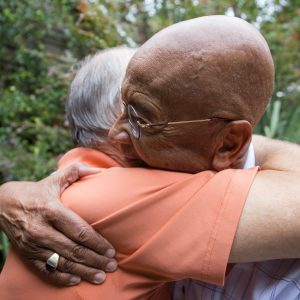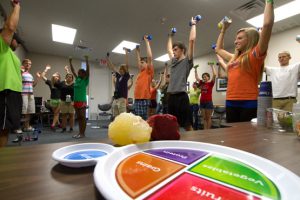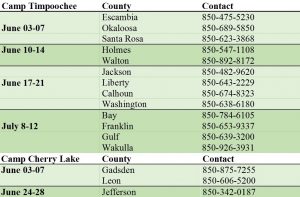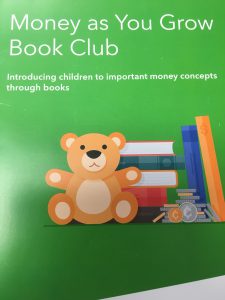
by Stephanie Herzog | Nov 27, 2019
The holidays are upon us! The holidays are a beloved time of year for many, but they are also a source of stress. Stress is defined by an individual’s values, beliefs, and perceptions, so it may look different to everyone. Whether you’re preparing for parties or family to come visit, dreading interacting with a certain family member, planning your holiday budget, or struggling with remembering a lost loved one, stress affects many people this time of year. Here are three tips for managing your stress this season.

Loving and caring relationships go a long way to relieve stress. (Photo Source: UF/IFAS)
1. Be Meta
Metacognition is thinking about your own thought processes. If you feel your stress winding up, stop and analyze your thought processes and the environment around you.
Ask yourself a question such as:
“Why I am feeling this way?” or “Why did I have this connecting thought and/or emotional reaction because of this specific event?”
Consciously recognize your signs of stress and do something about it:
“I’m feeling stressed because my muscles are tight and I’m irritable, so what is a healthy coping mechanism I like to use, and when can I take a break to go cope?”
Being more aware of your thoughts, feelings, and environment helps keep you in tune with managing your stress in a healthier way.
2. Take A Moment
Remember that to successfully help others, you first need to take care of yourself. The holidays make that even easier to forget, it seems. Too much psychological stress can lead to physical illness, which takes an even bigger toll on your overall well-being. So take a moment to yourself to refresh or recharge, whether it’s five minutes alone meditating or practicing mindfulness/awareness, going for a short walk, or taking an amazing 20-minute power nap. Reach out to friends and family to help you cover your responsibilities (such as caring for children), if needed, while you take a moment. Right now, I’d like you to take a moment and make a list of 3-5 simple things you can do to help yourself de-stress as the holidays approach, so you are armed with coping power when the stress arrives.
3. Don’t Deny
Denial is a poor stress management too; it’s a defense mechanism, not a healthy coping skill. It can be beneficial in the short-term, depending on the situation, but is largely harmful if used long-term. The refusal to believe there’s a problem only brings more stress. Not only does denial hurt you, but it hurts the people around you as well. Remember to trust those you love if they express concern about you or feel as though you’re denying something that’s negatively affecting you. Try not to defend yourself or attack them. First, take a step back, breathe in, and examine any validity to their claim with a good dose of humility. Chances are, they mean well and want to help, so it’s worth a self-examination. The ultimate goal is for you and your loved ones to be healthy and happy, and coping with stress positively is one great avenue to achieving that goal!
Enjoy yourself this time of year as you serve and spend time with others, but remember also to take care of yourself!
Source:
Boss, P. (2002). Family stress management: A contextual approach (2nd ed.). Thousand Oaks, California: Sage Publications.

by Stephanie Herzog | Oct 11, 2019
Have you ever been bullied or know someone who has been bullied? I know I have. October is National Bullying Prevention Month. Each October since 2006, there has been a national effort to raise awareness about bullying and provide education and resources to try to prevent it. According to data from 2017, about 20% of youth ages 12-18 experienced bullying at school and nearly 30% reported cyberbullying during their lifetime. That is a lot of our country’s youth!
What Exactly is Bullying?
Bullying is unwanted aggressive behavior. Bullying must have a real or perceived power imbalance between the bully and the victim, where the bully uses their power to control or hurt their victim. The bullying behavior needs to be repeated over time, or at least have the potential to repeat over time.
There are three categories of bullying:
- Verbal bullying includes teasing, taunting, threats, or name-calling
- Social or relational bullying includes ignoring someone on purpose, ostracizing, spreading rumors, or embarrassing someone
- Physical bullying includes damaging belongings or harming another’s body such as spitting, hitting, pushing, rude gestures, or tripping

The constant and easy access of cell phones, social media, and the internet has increased the real dangers of cyberbullying. (Photo source: UF/IFAS)
Cyberbullying
Technology has changed the ways of bullying. Bullying is no longer only ‘picking on’ someone, making fun of them, calling them names, or ignoring them at school. The constant and easy access of cell phones, social media, and the internet has truly expanded bullying to an unthinkable, unending scale. There are many ways to bully someone online, including:
- Verbal attacks, mean messages, or rumors on social media accounts, online games such as Fortnite, or through email or text
- Releasing embarrassing or inappropriate pictures, GIFs, or videos online or through text (e.g. sexting)
- Creating fake profiles or hacking into someone’s account online in order to hurt that person
Perhaps one of the most dangerous things about cyberbullying is once something is posted online and is circulated, it’s very hard to permanently remove. This oftentimes makes escape from the bullying unusually difficult or even seemingly impossible. It’s so important to keep up with ways technology is advancing in order to protect ourselves from things like cyberbullying.
Effects of Bullying
The negative psychological effects of bullying are very real – for the bully, the victim, and those who may witness it.
For the bully, they have a greater risk of using substances, engaging in risky or violent behavior, being abusive in future relationships, committing crimes, and developing other external behavior problems.
Effects of bullying include low self-esteem, fear, loneliness, heartache, and potential physical illness. These effects put a widespread toll on the mental, physical, and social health of the victims and also those who witness bullying. The increased risk of using addictive and illegal substances, anxiety, depression, eating disorders or even becoming suicidal are to be taken seriously and should be treated appropriately. Seek out mental health professionals or physicians and consult with them on the best combination of treatment. These effects can last days, months, years, or even lifetimes depending on the person and the circumstance.
The Story of Amanda Todd
The story of Amanda Todd is an unfortunate real example of cyberbullying and how unforgiving and never-ending it can be. Amanda ultimately committed suicide to get away from it; she was only 15 years old. Her YouTube video, published in 2012 a month before she committed suicide, has 13.5 million views to date. To better understand the reality of bullying, please consider watching it or sharing it. However, viewer discretion is advised.
Bullying, harassment, discrimination, or any other type of negative, cruel, or harmful behavior is never okay or acceptable in any way. If you have been a witness of bullying or a bully, stand up to stop it! If you have been bullied or know someone who has, please seek help from caring professionals, family, or friends. Go-to resources are found below.
Additional Resources
Stop Bullying Now Hotline: 1-800-273-8255
- Available 24/7, managed by the U.S. Department of Health and Human Services
National Suicide Prevention Lifeline: 1-800-273-8255
- Available 24/7, there is an online chat option available here
The Trevor Project: 1-866-488-7386
- Available 24/7, suicide prevention help specifically for the LGBTQ+ community
- Texting and chat options are available here
National Eating Disorders Association: 1-800-931-2237
- Mon-Thu 9am-9pm, Fri 9am-5pm
The Cybersmile Foundation
STOMP Out Bullying
Stopbullying.gov
Sources
National Center for Educational Statistics, Indicators of School Crime and Safety Indicator 10: Bullying at School and Electronic Bullying, April 2019.
Cyberbullying Research Center
The Amanda Todd Legacy

by Dorothy C. Lee | Jul 21, 2019
Eating healthy is not something that just happens by going on a particular diet. In fact, the best kind of diet is where the right choices are made, and it becomes a way of life. Sometimes we need to know some ways to change the bad habits we have developed. There is no ‘quick fix’.

Tune Up Your Lifestyle
Photo Source: UF/IFAS
With today’s fast-paced lifestyles sometimes we feel we don’t have the time to do the things we know we should. For instance, to get more exercise, do things like park a distance from the store when you go shopping, walk up and down the stairs instead of taking the elevator, walk to lunch, or even turn up the speed on regular activities you perform around the house.
When grocery shopping choose foods from the basic food groups (fruits, vegetables, whole grains, lean protein, and reduced-fat dairy products) to round out a healthy meal plan.
Convenience foods are a part of today’s lifestyle, but they often lack nutritional quality, texture, and flavor. Preparing foods at home can be healthy and economical. You can boost nutrition and flavor by adding fresh herbs, spices, and aromatic vegetables to the meal menu.
Foods and beverages high in sugar add empty calories to the diet and contribute no nutritional value. Read labels to determine the amount of added sugar in food products. Choose lower calorie beverages.
Experiment with new food items. Try adding different fruits, vegetables, or grains to your diet. For example, try tropical fruits such as mango, guava, papaya, or grains as quinoa, barley, or millet, to add vitamins, minerals and fiber to the diet.
Before you go out to eat, don’t starve yourself. Drink water before the meal to avoid overeating or eat a snack before dinner and you won’t be tempted to overeat.
When socializing don’t meet at eating places. When you do dine out, cut out fried main dishes or ones with heavy sauces and gravies. Eat smaller portions and don’t go back for seconds. Order low-fat foods when possible. However, keep in mind that you too need to allow for indulgence along the way.
Be active! Physical activity has health benefits. Being physically active not only burns calories, it aids in physical strength, and cardiovascular health. U.S. Dietary Guidelines recommend being physically active at least 150 minutes a week for adults. (https://health.gov/dietaryguidelines/).
Chances are, along with a healthy diet and regular physical activity, your tune up will result in living a healthy lifestyle.
https://www.freshfromflorida.com/Consumer-Resources/Buy-Fresh-From-Florida/Tropical-Fruit
https://www.tropicalfruitgrowers.com/
For further information, contact:
Dorothy C. Lee, C.F.C.S.
UF/IFAS Extension Escambia County
3740 Stefani Road
Cantonment, FL 32533-7792
(850) 475-5230
dclee@ufl.edu

by Melanie Taylor | May 6, 2019

Hanging with friends at 4-H Camp. Melanie Taylor as a 4-H Teen Counselor (right). Photo source: Melanie Taylor
Spring is upon us and 4-H Summer Camp preparations are in full swing. As a 4-H Agent preparing for our week of county 4-H camp, my days are busy with phone calls and emails from parents, teen counselor trainings, adult volunteer screenings, paperwork, paperwork, and more paperwork. Although this is a very busy time for me as a 4-H Agent, it also allows me to reflect on why I chose this career path and why there is a sense of nostalgia as I prepare for 4-H camp.
I attended 4-H camp in Virginia, where I grew up, every year from age 9-18. I was a camper who grew into a counselor-in-training and then a counselor. Those weeks of 4-H camp were filled with hot days and warm nights, but it was worth it all for the memories I will have for a lifetime. I can still smell the cafeteria food and hear the sounds in the gymnasium as kids played basketball and pounded at their leathercraft projects. I can feel the chills I would get as the entire camp sang around the campfire circle and patiently waited for the canoe to land on the lake’s edge; the camp staff would carry a flame as they entered the campfire circle and ceremoniously light the fire. Most importantly, I am still connected with my 4-H camp friends through social media and/or as close friends and we continue to share our old, blurry camp pictures from the 1990’s each year on Facebook.

Morning flag raising ceremony at Camp Timpoochee. Photo source: UF/IFAS Northwest District
So, as I work hard to prepare camp for my county campers and teen counselors, I want to create similar memories for them. In ten, twenty, and thirty years from now, I want them to think back on the fun moments they experienced in the Florida 4-H camping program. I also want them to form friendships and make camp connections for a lifetime, whether it is learning to kayak, fish, make arts and crafts, cook over a campfire, sing camp songs, etc.
With all of this said, I hope you as parents will consider giving your child(ren) these special moments. The days will be long, but fun, and their nights will be filled with campfires and hanging out with friends. When they arrive home on Friday, they will be exhausted, but so excited to share all of the camp songs with you (prepare yourself for lots of loud, enthusiastic singing). They will have new friends they want you to meet and they will tell you camp stories they will always cherish.
In Northwest Florida, there are two 4-H Camps, Camp Cherry Lake in Madison and Camp Timpoochee in Niceville. Each county in these camping districts has one county week of camp each summer. Contact your local UF/IFAS Extension Office now to find out the details and register your child for a week of fun and memories.

Northwest Florida 4-H Camp Dates 2019. Photo source: UF/IFAS Extension

by Heidi Copeland | Apr 30, 2019

The Consumer Financial Protection Bureau, (CFPB) has defined financial capacity as a the combination of attitude, knowledge, skills, and self-efficacy needed to make and exercise money management decisions that best fit the circumstances of one’s life, within an enabling environment that includes, but is not limited to, access to appropriate financial services.
Many of the attitudes, knowledge and skills needed to build financial capacity can be learned. People learn behavior through a variety of contexts. Children, in particular, learn through practices modeled by a parent or caregiver. In fact, research shows that parents and caregivers have the most influence on their children’s financial capability.
If you are like most parents, you probably recognize this—and you are interested in setting your kids on a good path toward financial well-being. However, many parents also say they do not always have time, tools, or personal confidence to start talking about money thinking their children will learn about it in school, later on, when they are old enough to understand.
This is most unfortunate. According to the Council for Economic Education 2018 Survey of the States, only 17 States require high school students to take a course in personal finance. So, if a parent isn’t teaching their children basic money/financial skills who is? Economical and financial literacy is a foundational element to achieving financial health and financial well-being. It is never too early (or too late) to start building this.
Talking to children about money, even in EARLY CHILDHOOD, helps children build the skills they need later in life. Early childhood education experts like to call this scaffolding. You are setting the framework…the support…the platform, encouraging financial capability milestones from early childhood into young adulthood. Children can learn the behaviors, knowledge, skills, and personal characteristics that support financial health and well-being.
Books can help start these critical early conversation. The CFPB has made it EASY! Parents can be their child’s first financial capability teacher! The University of Wisconsin-Extension Family Living Programs and the University of Wisconsin-Madison Center for Financial Security have selected books for the CFPB Money as you Grow Book Club. This program uses easy to read and understand children’s books to discuss money concepts. These books include many favorites:
- A Bargain for Frances, by Russell Hoban
- A Chair for My Mother, by Vera Williams
- Alexander, Who Used to Be Rich Last Sunday, by Judith Viorst
- Count on Pablo, by Barbara deRubertis
- Cuenta con Pablo, by Barbara deRubertis
- Curious George Saves His Pennies, by Margaret and H.AS. Rey
- Just Shopping With Mom, by Mercer Mayer
- Lemonade in Winter, by Emily Jenkins
- My Rows and Piles of Coins, by Tololwa M. Mollel
- Ox-Cart Man, by Donald Hall
- Sheep in a Shop, by Nancy Shaw
- The Berenstain Bears & Mama’s New Job, by Stan & Jan Berenstain
- The Berenstain Bears’ Trouble With Money by Stan and Jan Berenstain
- The Purse, by Kathy Caple
- The Rag Coat, by Lauren Mills
- Those Shoes, by Maribeth Boelts
- Tia Isa Wants a Car, by Meg Medina
- Tia Isa Quiere un Carro, by Meg Medina
Fortunately, many of the building blocks for good financial decision making – like self-regulation, patience, planning, and problem-solving – do not require a lot of financial know-how.
Reading books with children is a creative way to learn about the many sides of money management. Pick up a few of the titles at your local library and influence your children’s financial capability. Building good habits leads to a life of good financial health and well-being.
Example of key ideas from reading books:
| PLANNING |
How Children Show It |
| Making Decisions |
Can look at a few choices and select on what will bring the best results. |
| Setting Goals |
Can follow a multi–step plan. |
| Prioritizing |
Can prioritize choices when they want two or more things at once. |
| Solving problems
|
Can describe problems and come up with a few idea to make things better. |
| MONEY |
|
| Earning |
Can identify the different jobs people in the family and in the community do to earn money and keep it safe. |
| Spending |
Make spending choices with their own money – real or play. |
| Saving |
Keeps money in a safe place and keeps track of amount saved for future spending. |
| Sharing and borrowing |
Can explain the difference between lending and giving something away. |
| ME |
|
| Self-control |
Can talk about times when they were able to wait and how they were able to do it. |
| Follow-through |
Can identify who they can turn to for help reaching a goal, or what tools or tricks might help them stick with a plan. |
| Staying true to yourself |
Name one special thing they like about themselves and their loved ones. |
| Flexibility |
Can talk about a time when their plans did not turn out how they wanted and what they did instead. |
Resource: https://www.consumerfinance.gov/consumer-tools/money-as-you-grow/

by Angela Hinkle | Feb 11, 2019
Though not a widely publicized day on most calendars, Random Acts of Kindness Day, February 17th, is worth some attention. Random Acts of Kindness Day is a day when everybody gets the chance to do something nice for someone else.
A Little History
There’s a bit of debate over where and when it started. But it is generally believed to have started in Denver, Colorado in 1995. Then it spread to New Zealand in 2004. Since it apparently worked so well, it has since spread as an international holiday. So, now, we globally have a day dedicated to doing nice things for others.
Why Set Aside a Special Day?
Did someone recently cut you off in traffic? Are you tired of mean social media rants? Do too many of the people you encounter lately just seem rude? Does the only news you get seem to all be bad news? Then having one day to both offer and receive random acts of kindness just may give you the stop and reset buttons you need. You can plan out kind acts or just wing them spontaneously.

Giving and receiving brightens your day and makes you smile. Photo source: Angela Hinkle
Even the littlest kind thing you do for someone else can make a big difference in their day and yours. There’s the story I heard recently of a driver who brought a hamburger to a man living under a bridge at the beach. The homeless man said it was a perfect “surf and turf” lunch. The driver said that was one of the best days he ever had.
What Does the Research Say?
The effects of doing kind things for others is hard to scientifically pinpoint. However, multiple small case studies have shown that those practicing altruism live longer, healthier lives.* Kind deeds have been shown to reduce our stress levels and the negative physiological effects of stress on our bodies. “Happy” hormone levels increase as we care for others. There also is often a giddiness (not a scientific term) we feel when we do that nice unexpected thing for someone.
How to Celebrate
Doing nice for others can produce a ripple effect. You do something nice for someone. Then they do something nice for someone else. And so on, and so on, and so on. Your act of kindness does matter. Here are a few acts of kindness you may want to try:
- Pay for the person behind you at the drive thru.
- Give someone a compliment.
- Donate used business clothes to people who are going on job interviews.
- Let someone have that prime spot in the busy parking lot.
- Share your lunch.
- Clean up someone else’s mess.
- Leave a really big tip for your wait staff person.
- Donate blood.
Try a random act of kindness this February 17th. I think it will be worth it. And who knows, you may get so good at it, you start providing those random acts of kindness every day.
*Resource: The Science of Good Deeds: The ‘helper high’ could help you live a longer, healthier life. WebMD https://www.webmd.com/balance/features/science-good-deeds#1














